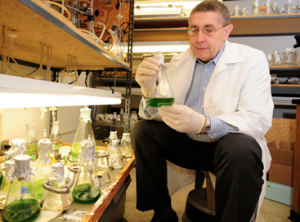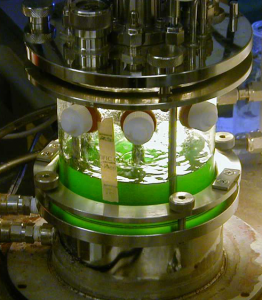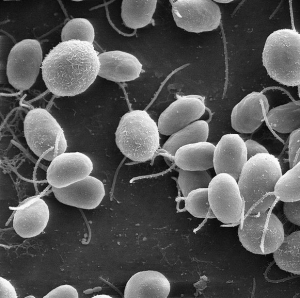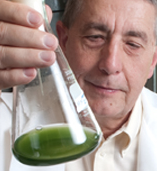
Researchers under the direction of geneticist Martin Spalding, at Iowa State University, have produced 50 to 80 percent more biomass by activating the expression of two separate Chlamydomonas algal genes, according to an Iowa State University press release.
In nature, algal growth is effected by the amount of carbon dioxide available. In low carbon environments, two genes -- LCIA and LCIB -- are expressed to capture more CO2 and direct it into the cells, promoting growth. However, when algae grow in an environment with enough CO2 to, the two genes shut down. The research's essence: turning the two on--even in carbon-rich environments, significantly increases growth. "The key to this increase in biomass is the necessary combination of two genes that increases the carbon conversion into organic matter by 50 percent," said Spalding.
He explained that the process is similar to driving a car up a hill. The accelerator--the two genes--is pressed as the engine climbs the hill (a low CO2 environment). Going downhill (when there is plenty of CO2), the driver lets up on the accelerator--shutting the genes down. Expressing the two genes, keeps algae's foot on the gas--even in a CO2-rich environment, producing extra biomasss, even where it would normally switch off and just coast, Spalding said.

But the researchers were still surprised by the unexpected productivity boost. "Based on some prior research we had done, we expected to see an increase in the 10 to 20 percent range," he said. "But we were surprised to see this big increase." Initially, Spalding had first expressed LCIA and LCIB separately, and each effort produced a 10 to 15 percent increase in biomass. But when the two genes were expressed together, Spalding was surprised to see the 50 to 80 percent increase.
"These two genes working together increase the amount of carbon dioxide that's converted through photosynthesis into biomass by the algae where you would expect there would already be enough carbon dioxide," said Spalding.
The excess biomass normally becomes starch through photosynthesis, and increases the biomass starch by around 80 percent. By using existing mutated genes, Spalding can instruct the algae to make oil instead of starch. But this process requires more

energy and the process results in around a 50 percent increase in oil biomass.
Why did Spalding chose the Chlamydomonas algae? He pragmatically explained that, "We have a sequenced genome, we understand the metabolism, and we have the tools available to us to work with this alga." (Watch a short video where he discusses the

basics of Chlamydomonas reinhardtii.)
"The advantage of using a genetically flexible alga like Chlamydomonas is that we can manipulate it in various ways to tailor it to what the needs are," he said. "Rather than look for an alga that produces trait 'x' or trait 'y' and then trying to adapt each new strain to production, which is a very difficult process, we are manipulating Chlamydomonas to meet x and y."
The end result could have several benefits.
"It will mean we will have a more sustainable source (of biofuels) than we have now--more sustainable and more flexible," Spalding said.
And since algae are not a feed source for animals, using algae for biofuels will not lead to higher commodity or food prices.


